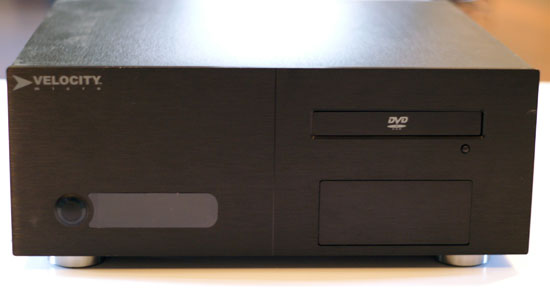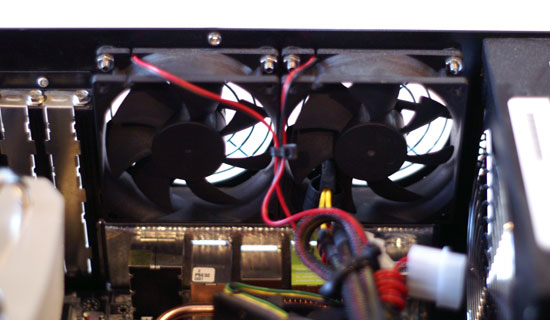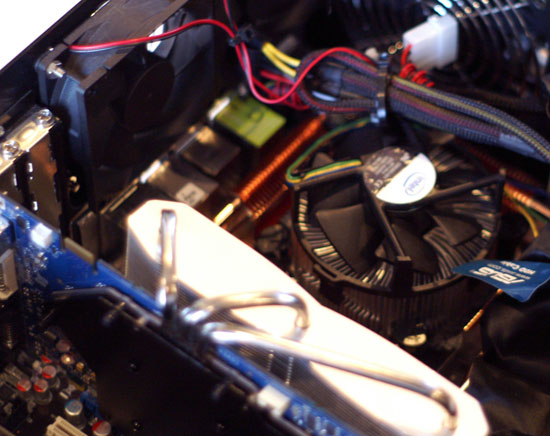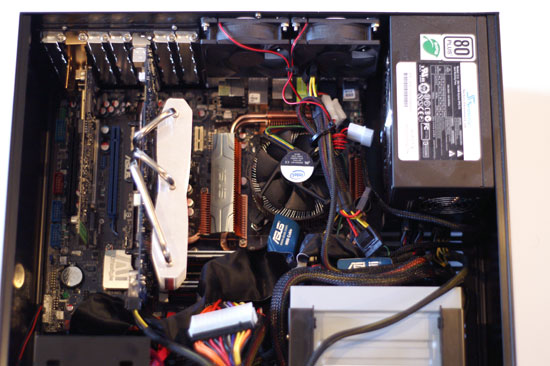Sparkle 8800 GT Passive: The Fastest Silent GPU in the World
by Anand Lal Shimpi on November 29, 2007 12:00 AM EST- Posted in
- GPUs
Getting it Going
Remember my skepticism from earlier? I was so eager to find out if this thing worked that I threw it into our Core 2 Extreme QX9770 testbed which was already setup and ready to accept such a thermally defiant graphics card.
Surprisingly enough, it worked. In working on the 8800 GT roundup I quickly discovered that Crysis was an excellent overclocking/thermal test. It turns out that a number of early overclocked 8800 GT boards were either overclocked too far or didn't have their fans set to come on early enough, resulting in a lot of crashing and general unpleasantness. What's most interesting is that these cards would complete our Oblivion and Bioshock tests without a problem, but just firing up Crysis and trying to change resolutions was enough to lock up the entire system. Thus Crysis would be the perfect game to stress test the passively cooled Sparkle.
The G92 GPU temperature maxed out at around 102C (215.6F), which is amazingly hot. The heatsink itself grew hotter than anything we remember ever touching outside of a kitchen. We had to do a sanity check and look up the burning point of paper just to make sure we weren't creating a fire hazard by running this thing.

This temp comes from our next test...
Surprisingly enough, the system remained stable and we continued to play Crysis and run through our normal gaming benchmarks without a hitch. However, we had no idea if the 8800 GT Passive would hold up under a more real-world scenario: inside a case.
Making it Hot
We did have an ulterior motive for pairing the Sparkle 8800 GT Passive with our QX9770 test bed, we wanted to toss it in a case with the hottest, fastest Intel processor we had.

We gutted a nearby Velocity Micro HTPC and swapped in our ASUS P5E3 Deluxe (X38) motherboard and QX9770. If you're not familiar with the QX9770, it's a quad-core 3.2GHz Penryn/Yorkfield based processor that won't be out until early 2008. It's got a TDP of 135W and manages to get quite warm, so putting it three inches away from the Sparkle's fanless heatsink just seemed like a great idea.
We also threw in a 150GB Western Digital Raptor hard drive, we could've gone with something cooler but where's the fun in that?

The chassis has two 80mm case fans in the back above the CPU and we tested with them both on and off. The Seasonic SS-700HM PSU has two fans of its own, so running the system without any extra case fans wouldn't be a huge deal.













55 Comments
View All Comments
qamca - Sunday, January 20, 2008 - link
Well, it occurs to me that the authors of this article have no intention on getting the coolest, but in somewhat beating the record of highest temperature out of this configuration....And if your PC case is so small and in such a mess and so crowded, I don't see why would anyone buy a passive cooled performance graphics card like this one... In fact I don't see why would anyone build any performance configuration in a case like this one??
Another test I read has successfully overclocked this card to 695/2000 without reaching 85C.
All you need is a tidy case and a well thought trough airflow in it.
So keep your pants on all you people scared of getting burned...
jay401 - Saturday, December 8, 2007 - link
"NVIDIA’s original target for the 8800 GT was $199 for the 256MB version and $249 - $259 for the 512MB version,"WHOAH WHOAH WHOAH. In your original review article, about the 512MB model, you said you expected prices would be $200-250 for the card. And in reality the 512MB WERE available for as low as $219 on launch day. So bullcrap to this revisionist "$249-259 for the 512MB version".
Nice attempt at trying to re-write history though. I'm sure NVidia appreciates it.
The reality is the reference design 512MB models were to be available as low as $200 (and we saw deals as low as $209 crop up within the first two weeks after launch). It was the over-clocked models that would approach $250-260 on the high end.
zshift - Monday, December 3, 2007 - link
google 111 c in f and you'll see that the card is running at 231.8 F. water boils at 212 F/100 C. that means you should never handle that card immediately after playing a game (i.e., u play a game, shut down pc, then switch out components, cards, etc.), or else you'll be holding a blistering hand, literally. so be careful out there if you buy this card.natrap - Wednesday, December 5, 2007 - link
111C is the temperature at the GPU where the sensor is located. The temperature on the surface of the card and the heatsink will be somewhat lower.BucDan - Saturday, December 1, 2007 - link
Sparkle is so bs to me..that cooler looks exactly like a thermalright hr-01 seriously... at least its not lke the hr-03/r600 lol...what losers gotta copy thermalright with their ideas.natrap - Saturday, December 1, 2007 - link
sorry for the multiple posts. silly thing kept spitting out error so it didn't look like it posted.natrap - Saturday, December 1, 2007 - link
I agree with Cerb. The fact that it reached 111C and did not fail is a good sign. And that was recorded with the case fans off in a poorly ventilated case. I'm gonna get this for an Antec Solo which has a single 120mm case fan at the rear over the CPU. I'd expect a temp a little lower. As for such high temps affecting the life of the card, well it does come with a 12 month warranty. If it hasn't failed in that time running close to 24/7 then the chance of it failing soon after isn't going to be a great deal higher.Cerb - Saturday, December 1, 2007 - link
If you want to add a fan, just get another card. The idea of a passive card is that your case can sufficiently move air to cool it, without adding another noise-maker.They put this GPU in a scenario that would be insane for anyone to actually try, and it DID NOT FAIL. In a decent case, with decent air flow and cable management, it should work excellently, without any modding.
Sure, you can get an aftermarket cooler and cool it better. In fact, you can probably do better passive, with something like the S1. But, that means more work, and more cost. Adding a fan, however good it cools it, basically defeats the purpose, though.
natrap - Saturday, December 1, 2007 - link
I agree with Cerb. The fact that it reached 111C and did not fail is a good sign. And that was recorded with the case fans off in a poorly ventilated case. I'm gonna get this for an Antec Solo which has a single 120mm case fan at the rear over the CPU. I'd expect a temp a little lower. As for such high temps affecting the life of the card, well it does come with a 12 month warranty. If it hasn't failed in that time running close to 24/7 then the chance of it failing soon after isn't going to be a great deal higher.natrap - Saturday, December 1, 2007 - link
I agree with Cerb. The fact that it reached 111C and did not fail is a good sign. And that was recorded with the case fans off in a poorly ventilated case. I'm gonna get this for an Antec Solo which has a single 120mm case fan at the rear over the CPU. I'd expect a temp a little lower. As for such high temps affecting the life of the card, well it does come with a 12 month warranty. If it hasn't failed in that time running close to 24/7 then the chance of it failing soon after isn't going to be a great deal higher.